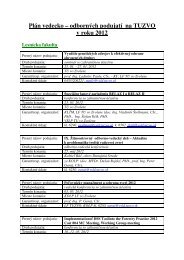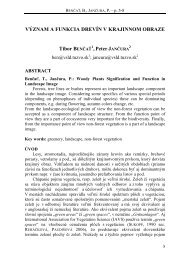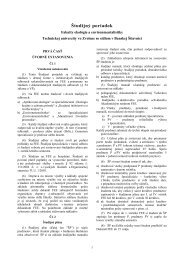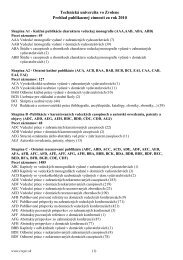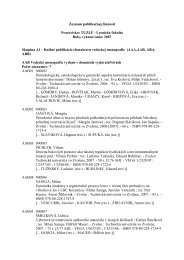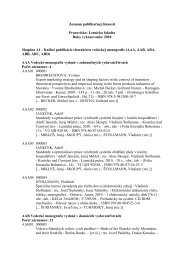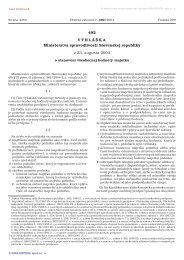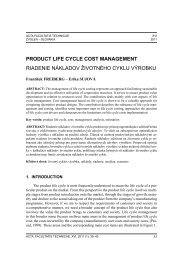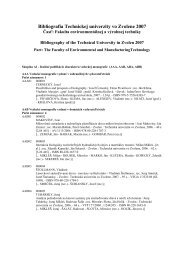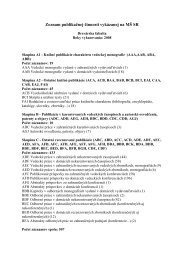Acta Facultatis Ecologiae - Technická univerzita vo Zvolene
Acta Facultatis Ecologiae - Technická univerzita vo Zvolene
Acta Facultatis Ecologiae - Technická univerzita vo Zvolene
- No tags were found...
You also want an ePaper? Increase the reach of your titles
YUMPU automatically turns print PDFs into web optimized ePapers that Google loves.
61ACTA FACULTATIS ECOLOGIAE, 16: Suppl. 1, 61– 66 Z<strong>vo</strong>len (Slovakia), 2007OUTDOOR RADON AS AN INDICATOR OF ATMOSPHERICSTABILITYMartin Bulko – Karol Holý – Anna Polášková – Ján Hr<strong>vo</strong>ľ – Ján ŠimonFaculty of Mathematics, Physics and Informatics, Comenius University, Mlynská dolina, 841 04 Bratislava, Slovakia,e-mail: bulko@fmph.uniba.skABSTRACTBulko M., Holý K., Polášková A., Hr<strong>vo</strong>ľ J. & Šimon J. Outdoor Radon as an Indicator of AtmosphericStabilityThis work deals with the potential use of radon as an indicator of atmospheric stability. Stability of theatmosphere is a parameter that can be used e.g. for quantitative assessment of pollutant dispersion in theground layer of the atmosphere. A rather good agreement was found between the courses of radon activityconcentration and stability indexes determined by modified Turner classification of atmospheric stability.The courses of radon concentration tend to lag behind the courses of stability indexes; this lag is of theorder of hours. It can be caused by the fact that unlike radon activity concentration in the ground layer ofthe atmosphere, the reaction of stability indexes to the change of meteorological parameters is immediate,because they are defined by table values. Several analyses presented in this paper also showed that there isa close connection between the time change of radon activity concentration and the time change of stabilityindexes. Then radon seems to be a good indicator of vertical mixing processes in the atmosphere, butfurther research on this issue is needed to confirm these results.Key words: outdoor radon, atmospheric stability, stability indexINTRODUCTIONDevelopment of industry and engineering hashad many adverse effects on the environment.A need for controlling the environment pollutionand its impact on the earth‘s biosphere is thereforestill topical. It is known that the aggregation ofpollutants in the lowest layers of the atmosphereoccurs under especially stable atmospheric conditions.Hence the degree of atmospheric stability isone of the most important parameters for evaluationof air pollution [1].Atmospheric stability can be determined on thebasis of meteorological parameters like the intensityof solar radiation, cloudiness, cloud height, visibility,period of day (daytime or night-time), windspeed and possibly temperature gradients. Numerousstudies [2, 3, 4] have shown that concentrationof gas (e.g. radon gas) in the atmosphere dependsmainly on vertical atmospheric stability. For thisreason, monitoring of 222 Rn activity concentrationcan bring information about stability of the atmospherein polluted area. 222 Rn is especially suitablefor this purposes since the radon exhalation ratefrom soil is approximately even, half-life of radonis long enough so that radon is able to escape bymeans of molecular diffusion from soil air into theatmosphere and because radon activity concentrationcan be measured with sufficient accuracy.The aim of this study was to examine closelythe relation between 222 Rn activity concentrationand indexes of stability determined by modifiedTurner method of atmospheric stability classification.At least certain agreement between the quantitiescan be expected because some studies indicatethat the variations of radon activity concentrations



